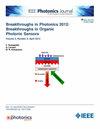Deep Learning Hybrid Architecture Based on Vision Transformer for Phase Analysis of Moiré Fringes
IF 2.4
4区 工程技术
Q3 ENGINEERING, ELECTRICAL & ELECTRONIC
引用次数: 0
Abstract
Overlay accuracy is a fundamental indicator of a photolithography machine performance. Misalignment between the mask and wafer is the main factor affecting overlay accuracy. The photolithographic alignment method, which uses Moiré fringes, is notable for its straightforward optical path and high precision. However, the alignment accuracy is significantly influenced by the Moiré fringe phase analysis algorithm. This paper proposes a hybrid deep learning architecture based on a Vision Transformer for Moiré fringe phase analysis. By training on various types of Moiré fringe datasets, the model can predict the fringe wrapping phase, allowing for the analysis of elements within the wrapping phase, including displacement information. This method combines the multi-head attention mechanism of a Vision Transformer with deep learning feature extraction to build a hybrid deep learning architecture. This model effectively learns the mathematical mapping between the Moiré fringe phase information and actual offset, accurately outputting true Moiré fringe phase data. Results show that despite the presence of Gaussian noise and tilted states, the hybrid architecture maintains a Root Mean Square Error (RMSE) within the range of 6–7 nm, and a Structural Similarity Index (SSIM) above 0.70, and Peak Signal-to-Noise Ratio (PSNR) is consistently maintained above 36. Consequently, the proposed model demonstrates superior robustness in handling noisy data compared to existing phase retrieval techniques. Additionally, the model has been optimized in structure to more efficiently extract phase information from complex Moiré fringe patterns. This study offers valuable insights for expanding Moiré fringe imaging applications.基于视觉变压器的条纹相位分析深度学习混合结构
覆盖精度是光刻机性能的基本指标。掩模与晶圆之间的不对准是影响叠加精度的主要因素。采用莫尔条纹的光刻准直方法具有光路直接、精度高的特点。但是,莫尔条纹相位分析算法对对准精度有很大的影响。提出了一种基于Vision Transformer的混合深度学习结构,用于条纹相位分析。通过对各种类型的莫尔条纹数据集进行训练,该模型可以预测条纹包裹阶段,允许分析包裹阶段内的元素,包括位移信息。该方法将视觉转换器的多头注意机制与深度学习特征提取相结合,构建了一种混合深度学习架构。该模型有效地学习了莫尔条纹相位信息与实际偏移量之间的数学映射关系,准确地输出了真实莫尔条纹相位数据。结果表明,尽管存在高斯噪声和倾斜状态,但混合结构的均方根误差(RMSE)保持在6 ~ 7 nm范围内,结构相似指数(SSIM)保持在0.70以上,峰值信噪比(PSNR)保持在36以上。因此,与现有的相位恢复技术相比,所提出的模型在处理噪声数据方面具有优越的鲁棒性。此外,该模型还对结构进行了优化,以更有效地从复杂的莫尔条纹图中提取相位信息。该研究为扩大莫尔条纹成像的应用提供了有价值的见解。
本文章由计算机程序翻译,如有差异,请以英文原文为准。
求助全文
约1分钟内获得全文
求助全文
来源期刊

IEEE Photonics Journal
ENGINEERING, ELECTRICAL & ELECTRONIC-OPTICS
CiteScore
4.50
自引率
8.30%
发文量
489
审稿时长
1.4 months
期刊介绍:
Breakthroughs in the generation of light and in its control and utilization have given rise to the field of Photonics, a rapidly expanding area of science and technology with major technological and economic impact. Photonics integrates quantum electronics and optics to accelerate progress in the generation of novel photon sources and in their utilization in emerging applications at the micro and nano scales spanning from the far-infrared/THz to the x-ray region of the electromagnetic spectrum. IEEE Photonics Journal is an online-only journal dedicated to the rapid disclosure of top-quality peer-reviewed research at the forefront of all areas of photonics. Contributions addressing issues ranging from fundamental understanding to emerging technologies and applications are within the scope of the Journal. The Journal includes topics in: Photon sources from far infrared to X-rays, Photonics materials and engineered photonic structures, Integrated optics and optoelectronic, Ultrafast, attosecond, high field and short wavelength photonics, Biophotonics, including DNA photonics, Nanophotonics, Magnetophotonics, Fundamentals of light propagation and interaction; nonlinear effects, Optical data storage, Fiber optics and optical communications devices, systems, and technologies, Micro Opto Electro Mechanical Systems (MOEMS), Microwave photonics, Optical Sensors.
 求助内容:
求助内容: 应助结果提醒方式:
应助结果提醒方式:


